Monitoring Cropping Intensity Dynamics across the North China Plain from 1982 to 2018 Using GLASS LAI Products
Abstract
:1. Introduction
2. Materials and Methods
2.1. Study Area
2.2. Data
2.2.1. Remotely Sensed LAI Data
2.2.2. Land Use Data
2.2.3. Statistical Data
2.3. Algorithms for Identifying the Cropping Intensity
2.3.1. Using Spatial Sampling to Obtain Sample Points in Pure Pixels of Cultivated Land Pixels
2.3.2. Extracting the Peaks of the LAI Curve
- (1)
- Smoothing of LAI time series curves
- (2)
- Extracting the number of peaks in the LAI curves
2.3.3. CI Estimation
- (1)
- Calculating the MCIs of the sample points
- (2)
- Spatial mapping of CI
3. Results
3.1. Smoothed LAI Time Series Curves
3.2. Extraction Results of the Peaks of the LAI Curve and the Determination of Valid Correct Peaks
- The peak shown occurred between day 120 and day 300 of a year;
- In the case of a unimodal peak, the LAI value at the peak should not be less than two;
- In the case of multimodal peaks, the LAI value at the smaller peak should not be less than 40% of the value of the highest peak.
3.3. Accuracy Assessment of the CI
3.3.1. Comparison of the MCIs in This Study with Statistical Data
3.3.2. Comparison of the MCI in This Study with Other Research Results
3.3.3. Cross Validation for the Cropping System of Cultivated Land over the NCP
3.4. Spatial and Temporal Patterns in CI of Cultivated Land on the NCP
3.4.1. Spatial Patterns in CI
3.4.2. Temporal Patterns in CI
4. Discussion
4.1. Applicability of GLASS LAI Data
4.2. Latitudinal Zonality of CI in Cultivated Land on the NCP
4.3. Uncertainty Analysis
- (1)
- The surface topography of the NCP was relatively complex: there were obvious regional differences and a range of crop planting systems were used. In addition, intercropping and interplanting occurred in many regions. This affected crop growth curves, which could have led to confusion in the peak extraction results and, thus, affecting the results of the identification of CI using remote sensing. At the same time, the existence of a large number of mixed pixels in data with a low or medium spatial resolution remained a key problem that restricted the study of CI on the NCP. Therefore, the use of different remote sensing extraction methods corresponding to different regional conditions are important directions for further research.
- (2)
- Due to the complex surface conditions on the NCP, grid-based spatial random sampling would produce certain sampling errors, which was another source of uncertainty. Therefore, in subsequent research, we will use adaptive sampling in different regions to improve the sampling accuracy and efficiency.
5. Conclusions
Author Contributions
Funding
Data Availability Statement
Acknowledgments
Conflicts of Interest
References
- Sonali, P.; Nagesh Kumar, D. Review of recent advances in climate change detection and attribution studies: A large-scale hydroclimatological perspective. J. Water Clim. Chang. 2020, 11, 1–29. [Google Scholar] [CrossRef]
- Wang, F. Impacts of climate change on cropping system and its implication for agriculture in China. Acta Meteorol. Sin. 1997, 11, 407–415. [Google Scholar]
- Yang, X.; Liu, Z.; Chen, F. The Possible Effects of Global Warming on Cropping Systems in China. The Possible Effects of Climate Warming on Northern Limits of Cropping Systems and Crop Yields in China. Sci. Agric. 2010, 43, 329–336. [Google Scholar]
- Iizumi, T.; Ramankutty, N. How do weather and climate influence cropping area and intensity? Glob. Food Sec. 2015, 4, 46–50. [Google Scholar] [CrossRef] [Green Version]
- Waha, K.; Philipp, J.; Portmann, F.T.; Siebert, S.; Thornton, P.K.; Bondeau, A.; Herrero, M. Multiple cropping systems of the world and the potential for increasing cropping intensity. Glob. Environ. Chang. 2020, 64, 102131. [Google Scholar] [CrossRef]
- Tang, P.; Wu, W.; Yao, Y. New method for extracting multiple cropping index of North China Plain based on wavelet transform. Trans. CSAE 2011, 27, 220–225. [Google Scholar]
- Min, J.; Xiubin, L.; Liangjie, X.; Minghong, T. Paddy rice multiple cropping index changes in Southern China: Impacts on national grain production capacity and policy implications. J. Geogr. Sci. 2019, 29, 1773–1787. [Google Scholar]
- Wu, W.B.; Yu, Q.Y.; Lu, M.; Xiang, M.T.; Xie, A.K.; Yang, P.; Tang, H.J. Key research priorities for multiple cropping systems. Sci. Agric. Sin. 2018, 51, 1681–1694. [Google Scholar]
- Fritz, S.; See, L.; Bayas, J.C.L.; Waldner, F.; Jacques, D.; Becker-Reshef, I.; Whitcraft, A.; Baruth, B.; Bonifacio, R.; Crutchfield, J.; et al. A comparison of global agricultural monitoring systems and current gaps. Agric. Syst. 2019, 168, 258–272. [Google Scholar] [CrossRef]
- Ge, Z.; Huang, J.; Lai, P.; Hao, B.; Zhao, Y.; Ma, M. Research Progress on Remote Sensing Monitoring of Cultivated Land Cropping Intensity. J. Geo-Inf. Sci. 2021, 23, 1–16. [Google Scholar]
- Panigrahy, S.; Manjunath, K.R.; Ray, S.S. Deriving cropping system performance indices using remote sensing data and GIS. Int. J. Remote Sens. 2005, 26, 2595–2606. [Google Scholar] [CrossRef]
- Zhou, H.; Wang, W.; Li, X.; Wang, Z. Remote sensing monitoring analysis for the multiple cropping index of the cultivated land in Shananxi province based on the long time-series NDVI. Agric. Res. Arid Areas 2014, 32, 189–195. [Google Scholar]
- Yan, H.; Liu, F.; Qin, Y.; Niu, Z.; Doughty, R.; Xiao, X. Tracking the spatio-temporal change of cropping intensity in China during 2000–2015. Environ. Res. Lett. 2018, 14, 1–28. [Google Scholar] [CrossRef]
- Xiang, M.; Yu, Q.; Wu, W. From multiple cropping index to multiple cropping frequency: Observing cropland use intensity at a fi ner scale. Ecol. Indic. 2019, 101, 892–903. [Google Scholar] [CrossRef]
- Ozdogan, M.; Woodcock, C.E. Resolution dependent errors in remote sensing of cultivated areas. Remote Sens. Environ. 2006, 103, 203–217. [Google Scholar] [CrossRef]
- Xie, H.; Liu, G. Spatiotemporal differences and influencing factors of multiple cropping index in China during 1998–2012. J. Geogr. Sci. 2015, 25, 1283–1297. [Google Scholar] [CrossRef]
- Sakti, A.D.; Takeuchi, W. A data-intensive approach to address food sustainability: Integrating optic and microwave satellite imagery for developing long-term global cropping intensity and sowing month from 2001 to 2015. Sustainability 2020, 12, 3227. [Google Scholar] [CrossRef] [Green Version]
- Li, J.; Ren, Z. The Monitoring for cropping index of arable land in northwest region using SPOTNDVI—A case of Shaanxi Province. J. Arid L. Resour. Environ. 2011, 25, 86–91. [Google Scholar]
- Yang, R.; Liu, Y.; Chen, Y.; Li, T. The remote sensing inversion for spatial and temporal changes of multiple cropping index and detection for influencing factors around Bohai rim in China. Sci. Geogr. Sin. 2013, 33, 588–593. [Google Scholar]
- Ding, M.; Chen, Q.; Xin, L.; Li, L.; Li, X. Spatial and temporal variations of multiple cropping index in China based on SPOT-NDVI during 1999–2013. Dili Xuebao/Acta Geogr. Sin. 2015, 70, 1080–1090. [Google Scholar]
- Conrad, C.; Schönbrodt-Stitt, S.; Löw, F.; Sorokin, D.; Paeth, H. Cropping intensity in the Aral Sea Basin and its dependency from the runoffformation 2000–2012. Remote Sens. 2016, 8, 630. [Google Scholar] [CrossRef] [Green Version]
- Estel, S.; Kuemmerle, T.; Levers, C.; Baumann, M.; Hostert, P. Mapping cropland-use intensity across Europe using MODIS NDVI time series. Environ. Res. Lett. 2016, 11, 24015. [Google Scholar] [CrossRef] [Green Version]
- Liu, C.; Zhang, Q.; Tao, S.; Qi, J.; Ding, M.; Guan, Q.; Wu, B.; Zhang, M.; Nabil, M.; Tian, F.; et al. A new framework to map fine resolution cropping intensity across the globe: Algorithm, validation, and implication. Remote Sens. Environ. 2020, 251, 112095. [Google Scholar] [CrossRef]
- Canisius, F.; Turral, H.; Molden, D. Fourier analysis of historical NOAA time series data to estimate bimodal agriculture. Int. J. Remote Sens. 2007, 28, 5503–5522. [Google Scholar] [CrossRef]
- Sakamoto, T.; Van Nguyen, N.; Ohno, H.; Ishitsuka, N.; Yokozawa, M. Spatio-temporal distribution of rice phenology and cropping systems in the Mekong Delta with special reference to the seasonal water flow of the Mekong and Bassac rivers. Remote Sens. Environ. 2006, 100, 1–16. [Google Scholar] [CrossRef]
- Li, Z.; Liu, S.; Sun, R.; Liu, W. Identifying the temporal- spatial pattern evolution of the multiple cropping index in the Huang-Huai-Hai region. Acta Ecol. Sin. 2018, 38, 4454–4460. [Google Scholar]
- Li, Y.; Qiu, B.; He, Y.; Chen, G.; Ye, Z. Cropping intensity based on MODIS data in China during 2001–2018. Prog. Geogr. 2020, 39, 1874–1883. [Google Scholar] [CrossRef]
- Gray, J.; Friedl, M.; Frolking, S.; Ramankutty, N.; Nelson, A.; Gumma, M.K. Mapping Asian cropping intensity with MODIS. IEEE J. Sel. Top. Appl. Earth Obs. Remote Sens. 2014, 7, 3373–3379. [Google Scholar] [CrossRef]
- Niu, Z.; Yan, H.; Liu, F. Decreasing cropping intensity dominated the negative trend of cropland productivity in southern China in 2000–2015. Sustainability 2020, 12, 10070. [Google Scholar] [CrossRef]
- Huete, A.; Didan, K.; Miura, T.; Rodriguez, E.P.; Gao, X.; Ferreira, L.G. Overview of the radiometric and biophysical performance of the MODIS vegetation indices. Remote Sens. 2020, 12, 195–213. [Google Scholar] [CrossRef]
- Chandna, P.K.; Mondal, S. Assessment of cropping intensity dynamics in Odisha using multitemporal Landsat TM and OLI images. J. Appl. Remote Sens. 2020, 14, 1–23. [Google Scholar] [CrossRef]
- Jain, M.; Mondal, P.; DeFries, R.S.; Small, C.; Galford, G.L. Mapping cropping intensity of smallholder farms: A comparison of methods using multiple sensors. Remote Sens. Environ. 2013, 134, 210–223. [Google Scholar] [CrossRef] [Green Version]
- Liu, L.; Xiao, X.; Qin, Y.; Wang, J.; Xu, X.; Hu, Y.; Qiao, Z. Mapping cropping intensity in China using time series Landsat and Sentinel-2 images and Google Earth Engine. Remote Sens. Environ. 2020, 239, 111624. [Google Scholar] [CrossRef]
- Hao, P.-y.; Tang, H.-j.; Chen, Z.-x.; Yu, L.; Wu, M.-q. High resolution crop intensity mapping using harmonized Landsat-8 and Sentinel-2 data. J. Integr. Agric. 2019, 18, 2883–2897. [Google Scholar] [CrossRef]
- Kovalskyy, V.; Roy, D.P. The global availability of Landsat 5 TM and Landsat 7 ETM+ land surface observations and implications for global 30m Landsat data product generation. Remote Sens. Environ. 2013, 130, 280–293. [Google Scholar] [CrossRef] [Green Version]
- Yu, L.; Shi, Y.; Gong, P. Land cover mapping and data availability in critical terrestrial ecoregions: A global perspective with Landsat thematic mapper and enhanced thematic mapper plus data. Biol. Conserv. 2015, 190, 34–42. [Google Scholar] [CrossRef]
- Li, P.; Zhang, C.; Yun, W.; Yang, J.; Zhu, D. Analysis of Cultivated Land Fragmentation in Beijing- Hebei Region Based on Kernel Density Estimation. Trans. Chin. Soc. Agric. Mach. 2016, 47, 281–287. [Google Scholar]
- Wu, X.; Qi, Y.; Shen, Y.; Yang, W.; Zhang, Y.; Kondoh, A. Change of winter wheat planting area and its impacts on groundwater depletion in the North China Plain. J. Geogr. Sci. 2019, 29, 891–908. [Google Scholar] [CrossRef] [Green Version]
- Cui, Y.; Zhang, B.; Huang, H.; Zeng, J.; Wang, X.; Jiao, W. Spatiotemporal Characteristics of Drought in the North China Plain over the Past 58 Years. Atmosphere 2021, 12, 844. [Google Scholar] [CrossRef]
- Yan, H.; Liu, F.; Niu, Z.; Gu, F.; Yang, Y. Changes of multiple cropping in Huang-Huai-Hai agricultural region, China. J. Geogr. Sci. 2018, 28, 1685–1699. [Google Scholar] [CrossRef] [Green Version]
- Zhang, S.; Bai, Y.; Zhang, J. Remote Sensing-Based Quantification of the Summer Maize Yield Gap Induced by Suboptimum Sowing Dates over North China Plain. Remote Sens. 2021, 13, 3582. [Google Scholar] [CrossRef]
- Liang, B.; Liu, S.; Qu, Y.; Zhou, G.; He, X. Changes in the Amazon rainforest from 1982 to 2012 using GLASS LAI data. J. Remote Sens. 2016, 20, 149–156. [Google Scholar]
- Pourmansouri, F.; Rahimzadegan, M. Evaluation of vegetation and evapotranspiration changes in Iran using satellite data and ground measurements (Erratum). J. Appl. Remote Sens. 2020, 14, 34530. [Google Scholar] [CrossRef]
- Li, K.; Yang, X.; Liu, Y.; Xun, X.; Liu, Z.; Wang, J.; Lv, S.; Wang, E.-L. Distribution Characteristics of Winter Wheat Yield and Its Influenced Factors in North China. Acta Agron. Sin. 2013, 38, 1483–1493. [Google Scholar] [CrossRef]
- Luo, Y.; Pan, Y.; Zhou, Y. Discrepancies of satellite-derived leaf area index products in Zhejiang Province. Res. Agric. Mod. 2019, 40, 851–861. [Google Scholar]
- Li, J.; Xiao, Z. Evaluation of the version 5.0 global land surface satellite (GLASS) leaf area index product derived from MODIS data. Int. J. Remote Sens. 2020, 41, 9140–9160. [Google Scholar] [CrossRef]
- Xiang, Y.; Xiao, Z.; Liang, S.; Wang, J.; Song, J. Validation of Global LAnd Surface Satellite (GLASS) leaf area index product. J. Remote Sens. 2014, 18, 573–596. [Google Scholar]
- Fang, H.; Baret, F.; Plummer, S.; Schaepman-Strub, G. An Overview of Global Leaf Area Index (LAI): Methods, Products, Validation, and Applications. Rev. Geophys. 2019, 57, 739–799. [Google Scholar] [CrossRef]
- Tatsumi, K. Cropping intensity and seasonality parameters across asia extracted by multitemporal SPOT vegetation data. J. Agric. Meteorol. 2016, 72, 142–150. [Google Scholar] [CrossRef] [Green Version]
- Zhou, J.; Jia, L.; Menenti, M.; Gorte, B. On the performance of remote sensing time series reconstruction methods—A spatial comparison. Remote Sens. Environ. 2016, 187, 367–384. [Google Scholar] [CrossRef]
- Nguyen, H.T.T.; Van Nguyen, L.; de Bie, C.A.J.M.; Ciampitti, I.A.; Nguyen, D.A.; Van Nguyen, M.; Nieto, L.; Schwalbert, R.; Nguyen, L.V. Mapping Maize Cropping Patterns in Dak Lak, Vietnam Through MODIS EVI Time Series. Agronomy 2004, 10, 478. [Google Scholar] [CrossRef] [Green Version]
- Steinier, J.; Termonia, Y.; Deltour, J. Smoothing and differentiation of data by simplified least square procedure. Anal. Chem. 1972, 44, 1906–1909. [Google Scholar] [CrossRef]
- Ding, M.; Chen, Q.; Xiao, X.; Xin, L.; Zhang, G.; Li, L. Variation in cropping intensity in northern China from 1982 to 2012 based on GIMMS-NDVI data. Sustainability 2016, 8, 1123. [Google Scholar] [CrossRef] [Green Version]
- Yang, H.; Deng, F.; Zhang, J.; Wang, X.; Ma, Q.; Xu, N. A study of information extraction of rape and winter wheat planting in Jianghan Plain based on MODIS EVI. Remote Sens. Land Resour. 2020, 32, 208–215. [Google Scholar]
- Shen, J.; Chang, Q.; Li, F.; Wang, L. Extraction of Winter Wheat Information Based on Time- series NDVI in Guanzhong Area. Trans. Chin. Soc. Agric. Mach. 2017, 48, 215–220. [Google Scholar]
- Zhao, Y.; Bai, L.; Feng, J.; Lin, X.; Wang, L.; Xu, L.; Ran, Q.; Wang, K. Spatial and temporal distribution of multiple cropping indices in the North China plain using a long remote sensing data time series. Sensors 2016, 16, 557. [Google Scholar] [CrossRef] [Green Version]
- Zeng, H.; Huang, S. Research on spatial data interpolation based on Kriging interpolation. Eng. Surv. Map. 2007, 16, 5–8. [Google Scholar]
- Teng, M.; She, M.; He, K. An Improved Algorithm for Bridge Crack Information Extraction. Urban Geotech. Investig. Surv. 2017, 12, 71–83. [Google Scholar]
- Yan, Z.; Qian, S.; Wei, W.; Zhongxin, C.; Peng, Y. Spatio-temporal characteristics of cropland phenophase in North China based on NDVI time series data. Chin. J. Agric. Resour. Reg. Plan. 2017, 38, 1–9. [Google Scholar]
- Wang, X.T.; Zhang, S.; Deng, F.; Zhang, J.H. Mapping the cultivation areas of summer maize using spatial variations of crop phenology over huanghuaihai plain. Chin. J. Agrometeorol. 2019, 40, 647–659. [Google Scholar]
- Wang, R.; Jiang, H.; Jin, J.; Cheng, M. Response of winter wheat phenology to climate change and its effect on yield in Huang-Huai-Hai region. Jiangsu Agric. Sci. 2018, 46, 71–75. [Google Scholar]
- Fan, J.; Wu, B. A Methodology for Retrieving Cropping Index from NDVI Profile. J. Remote Sens. 2004, 8, 628–636. [Google Scholar]
- Zhao, X.; Liang, S.; Liu, S.; Yuan, W.; Xiao, Z.; Liu, Q.; Cheng, J.; Zhang, X.; Tang, H.; Zhang, X.; et al. The global land surface satellite (GLASS) remote sensing data processing system and products. Remote Sens. 2013, 5, 2436–2450. [Google Scholar] [CrossRef] [Green Version]
- Yang, F.; Li, Z.; Bao, Y.; Li, X.; Zhang, B.; Xin, X. Comparation of different LAI products in hulunber meadow steppe. Trans. Chin. Soc. Agric. Eng. 2016, 32, 153–160. [Google Scholar]
- Guo, Z.; Xie, X.; Liu, S. K-Nearest neighbors sparse outlier removal algorithm based on frequency histogram. Com. Appli. Soft. 2016, 33, 169–172. [Google Scholar]
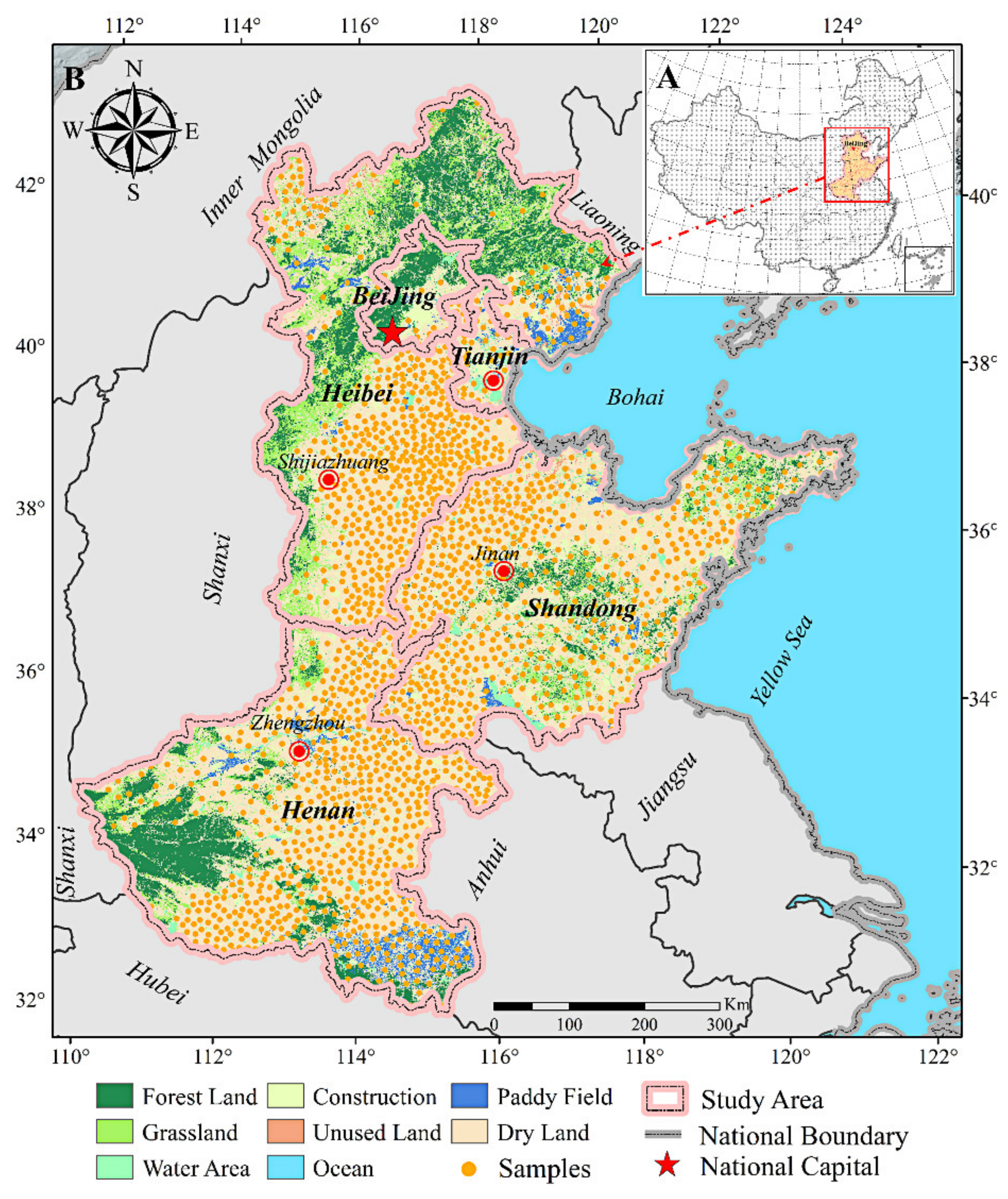

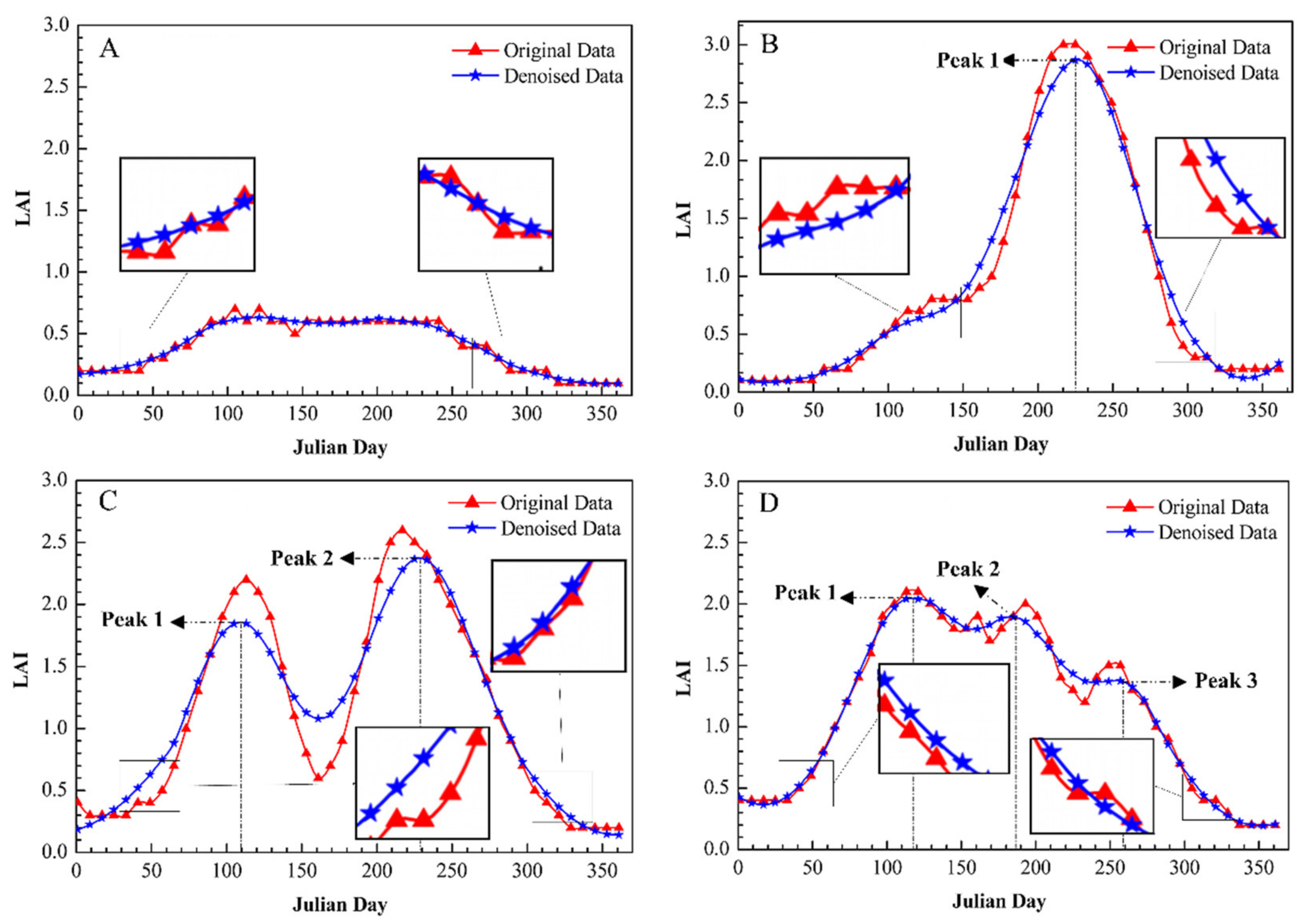
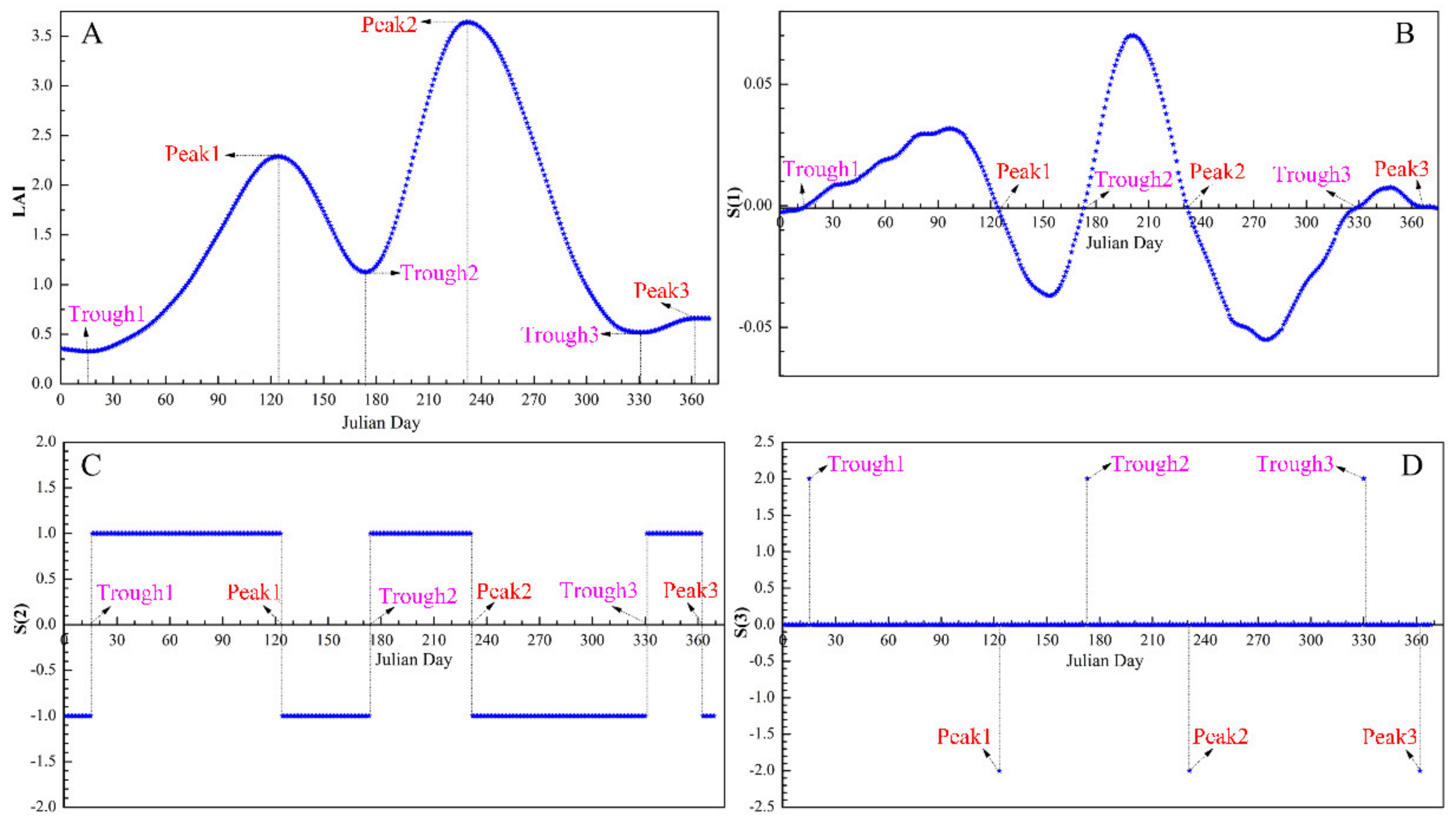
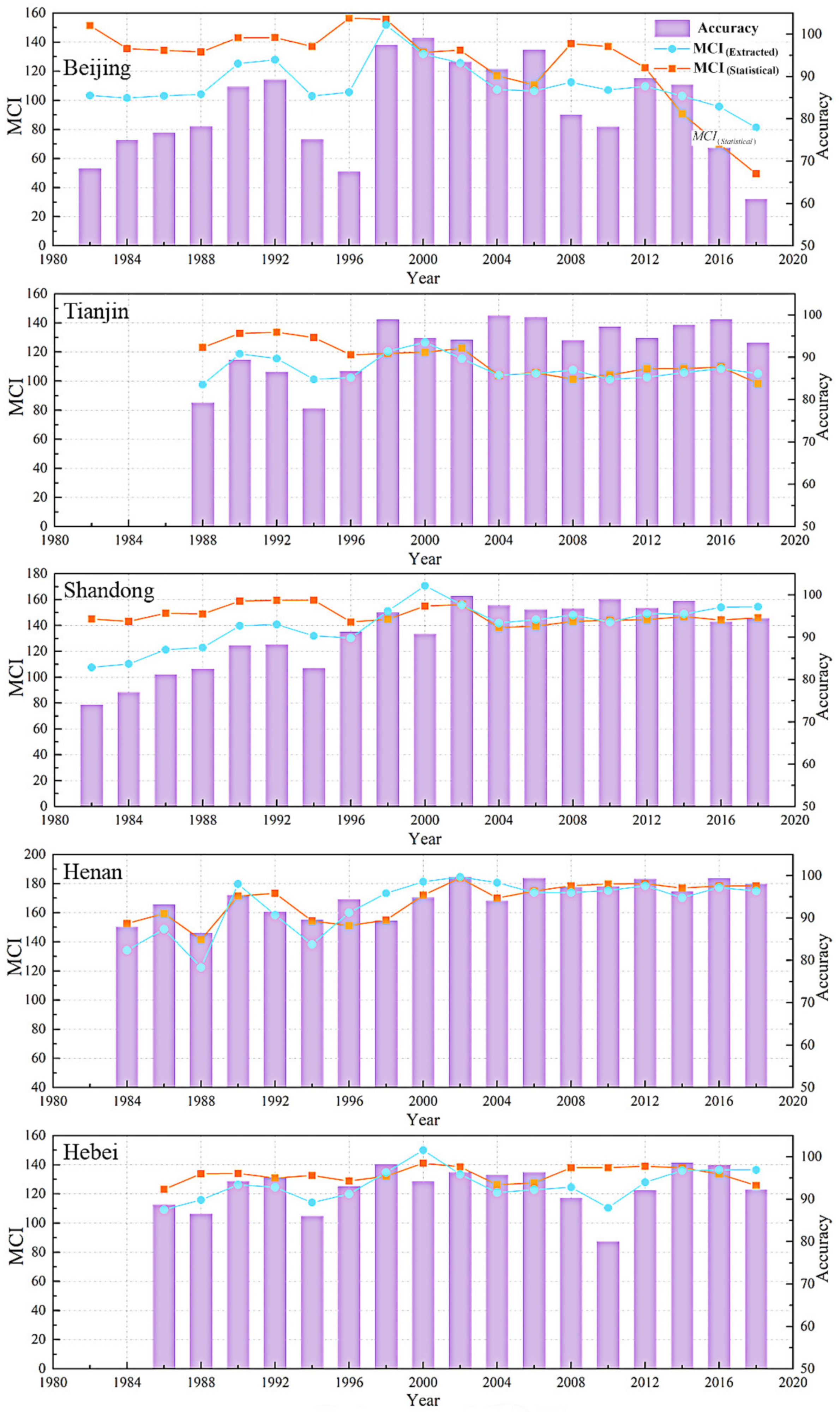

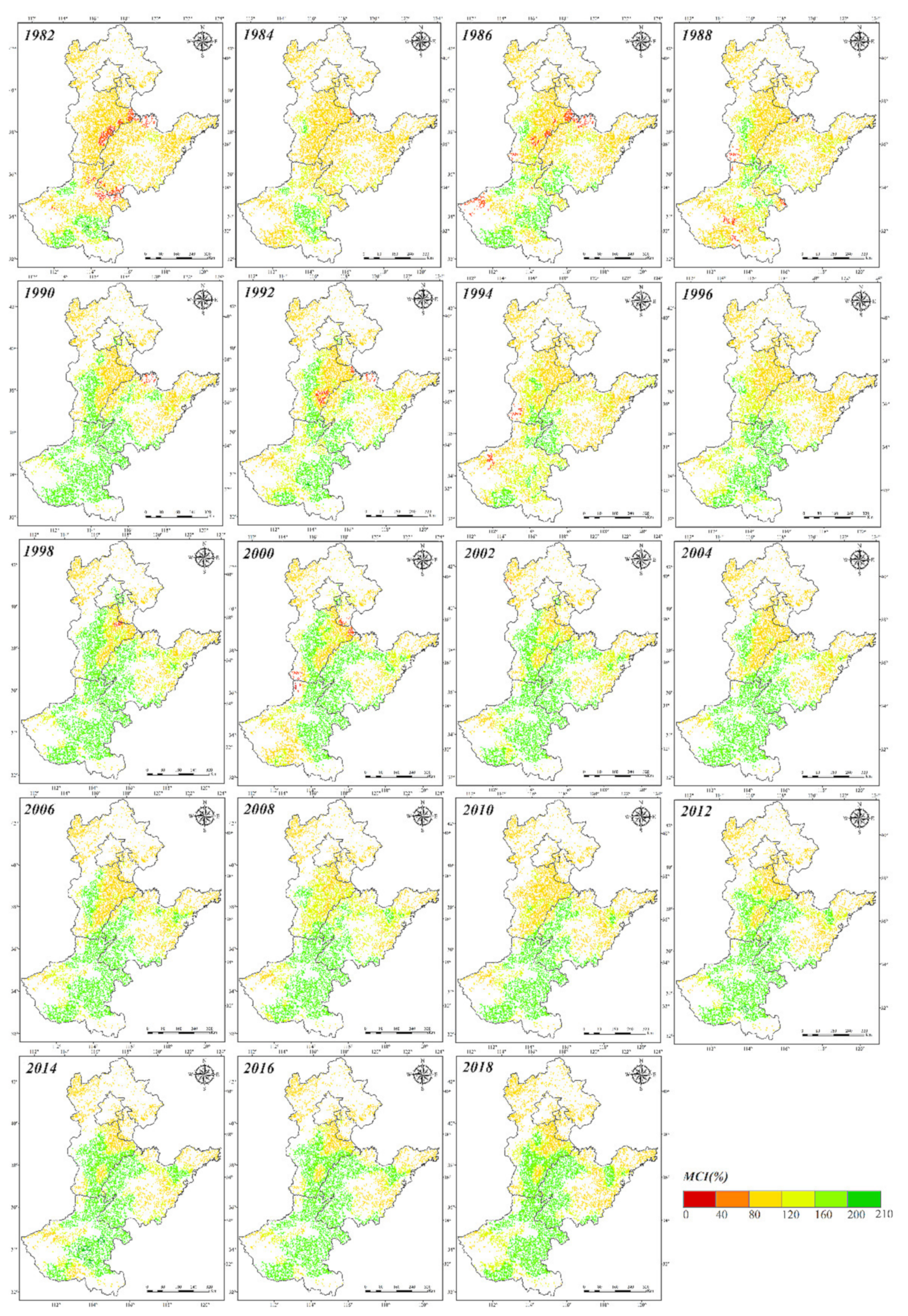





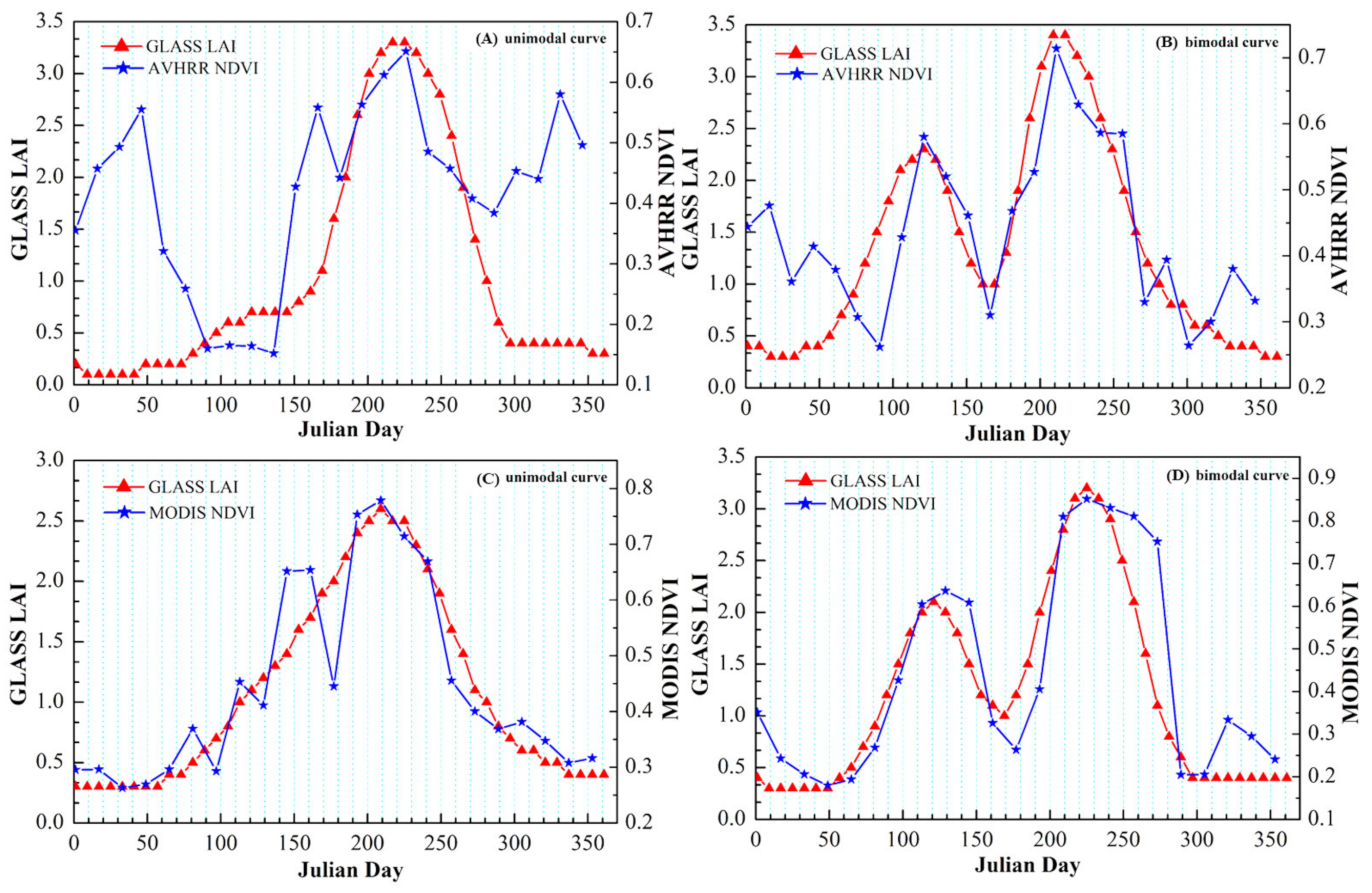


| Data Type | Dataset | Sensor | Format | Spatial Projection | Time Range | Temporal Resolution | Spatial Resolution |
|---|---|---|---|---|---|---|---|
| GLASS LAI | GLASS LAI (1982–2000) | AVHRR | HDF-EOS | geographic projection | 1982–2000 | 8 days | 0.05° |
| GLASS LAI (2001–2016) | MODIS | HDF-EOS | Integrated Sinusoidal projection | 2001–2016 | 8 days | 0.05°, 1 km, 500 m |
| Interpolation Results | Extraction Results | ||||
|---|---|---|---|---|---|
| Fallow Field | SCS | DCS | Total | User Accuracy | |
| Fallow Field | 13 | 20 | 10 | 43 | 30.23% |
| SCS | 0 | 856 | 285 | 1141 | 75.02% |
| DCS | 0 | 64 | 842 | 906 | 92.94% |
| Total | 13 | 940 | 1137 | 2090 | -- |
| Producer Accuracy | 100% | 91.06% | 74.05% | -- | -- |
| Overall Accuracy = 81.87% | |||||
| Kappa Coefficient = 0.65 | |||||
Publisher’s Note: MDPI stays neutral with regard to jurisdictional claims in published maps and institutional affiliations. |
© 2021 by the authors. Licensee MDPI, Basel, Switzerland. This article is an open access article distributed under the terms and conditions of the Creative Commons Attribution (CC BY) license (https://creativecommons.org/licenses/by/4.0/).
Share and Cite
Zhao, Y.; Feng, J.; Luo, L.; Bai, L.; Wan, H.; Ren, H. Monitoring Cropping Intensity Dynamics across the North China Plain from 1982 to 2018 Using GLASS LAI Products. Remote Sens. 2021, 13, 3911. https://doi.org/10.3390/rs13193911
Zhao Y, Feng J, Luo L, Bai L, Wan H, Ren H. Monitoring Cropping Intensity Dynamics across the North China Plain from 1982 to 2018 Using GLASS LAI Products. Remote Sensing. 2021; 13(19):3911. https://doi.org/10.3390/rs13193911
Chicago/Turabian StyleZhao, Yan, Jianzhong Feng, Lei Luo, Linyan Bai, Hong Wan, and Hongge Ren. 2021. "Monitoring Cropping Intensity Dynamics across the North China Plain from 1982 to 2018 Using GLASS LAI Products" Remote Sensing 13, no. 19: 3911. https://doi.org/10.3390/rs13193911





